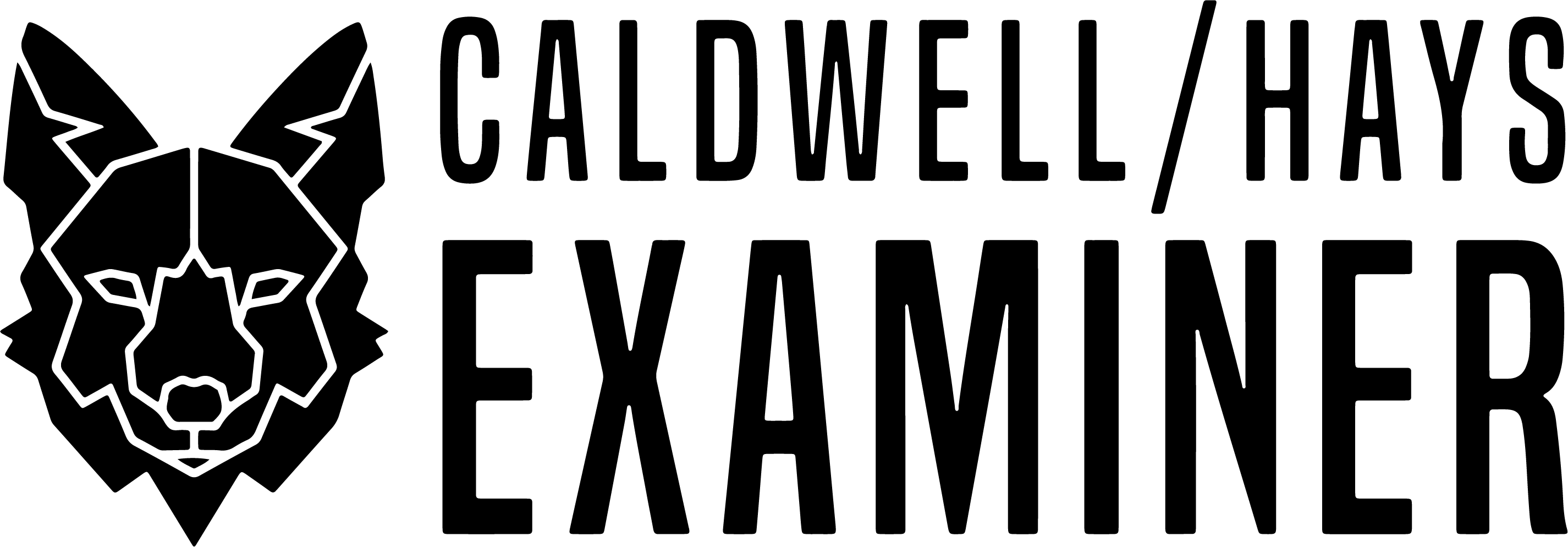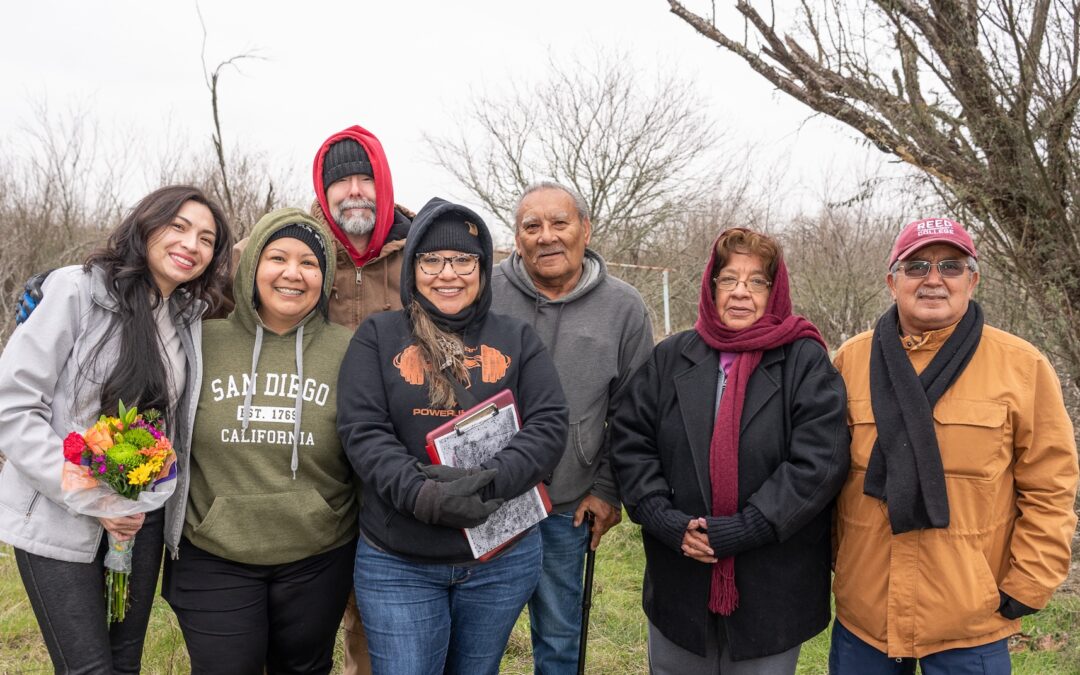Families met at Maxwell Hispanic Cemetery to clean up. Pictured: (front, L-R) Jeanette Ramos, Sandie Alvarez Hall, Linda Gonzales, Angie Gonzales & Lazaro Rocha, (back, L-R) Rob Hall & Robert Gonzales. Photo by Ursula Rogers
In the western corner of Caldwell County, hidden in a thicket of tall grass and thorny mesquite, lies the front line of an ongoing battle to preserve Mexican-American heritage in Texas. At just over an acre, Maxwell Hispanic Cemetery is a small plot located not far off State Highway 142. But for two families it is the site of a multigenerational struggle against time and the elements to ensure that those buried there are not lost to history.
Linda Gonzales, whose great grandfather and other ancestors are buried in the cemetery, has worked with her family for decades to maintain and upkeep the site.
“He put me to work at 6 or 7,” she says, speaking of her maternal grandfather Fernando Duran Rocha, who cared for the cemetery even into his 90s. “I’m 36 right now. I’ve been out here all my life, basically, helping.”
Linda, like many members of the Hispanic community who grew up in the Maxwell area, is a descendant of Mexican immigrants who arrived in Caldwell County in the late 1800s in search of work and a better life.
“We were born and raised here,” confirms Angie Gonzales, Linda’s mother and current Austin resident who grew up on the property. She recalls the closeness of the community living and working on the farm, and how neighbors would help each other in times of sickness and need. The remains of the house she was born in sits less than a mile from the cemetery gate. “My baby brothers were born 1946. They lived here. They walked across with the coffin and buried them there.”
The private property on which Maxwell Hispanic Cemetery is located was originally owned by Robert M. Martindale. According to the 1918 biography “Texas, The Country and its Men,” Martindale was a businessman, Texas legislator, and Confederate veteran who moved to Texas from Mississippi in 1851. After the Civil War he established a farm and general store in the county, allowing the Mexican farm workers he employed to live on his property in exchange for their labor and designating the area that is now the cemetery as a space for them to bury their loved ones. The site had various names over time – including San Pablo Cemetery and Mexican Dry Branch Cemetery – before being officially registered under its current name in the late 1990s.
Dr. Ana Juárez, cultural anthropologist and associate professor emerita of Texas State University, says the precedent of ranchers ordering the burials of their workers was common in the days of the cemetery’s establishment, with the post-Civil War agricultural landscape still closely modeling the plantation system of the decades prior. “Originally it was more like working for cotton plantations,” says Dr. Juárez. “After the Civil War, you got more kind of recruitment of Mexicans to replace slave labor, and the population grew that way.” Because cities and counties did not offer burial services to nonwhite residents, segregated cemeteries for Mexican-Americans prevailed in Texas until after WWII.
Today, accessibility is the biggest goal for those with loved ones buried in the cemetery. Overgrowth of vegetation has prevented elderly visitors and those with mobility issues from accessing the site without assistance, and the dirt road makes it difficult for individuals with smaller vehicles from even reaching the gates. Major floods in the area have knocked over some headstones and completely buried others, while the wooden crosses that marked many more graves have almost all but deteriorated. The families would additionally like to see the cemetery receive recognition from the Texas Historical Commission, as was the vision of Linda’s grandfather Fernando Duran Rocha before he passed. Standing in the cemetery as I did on an overcast morning in late January, you cannot help but feel the weight of the increasingly urgent task that is uncovering and preserving what remains of this historical resting place.
Leander resident Sandie Alvarez Hall also has relatives buried in the cemetery, and in February 2023 was able to locate her great-grandfather’s resting place using information on Find-A-Grave uploaded by Linda Gonzales and her family. She recalls navigating using coordinates on Google Maps, feeling compelled to launch her search while in the Maxwell area on other business. After she passed livestock carcasses and barbed-wire fences, the straight edge of a headstone peeking out through the vegetation let her know she had found the cemetery.
“For some reason, I think something just was telling me you’re going to find it and don’t give up,” Sandie says of the experience, remembering her determination. “There are wild pigs out here. There’s coyotes. There’s hunters out here that if they see something moving, and they might think it’s an animal. And I’m like, none of that even crossed my mind.”
Within a month, Sandie and Linda’s family had cleared enough vegetation to bring Sandie’s grandmother Ninfa Alvarez to the site, marking the first time in 50 years that she had laid eyes on her father’s grave.
An additional obstacle is the fact that the families must ask permission from the current property owner to even access their loved ones’ graves.
“I love it. I wish I could come every day,” says Angie. Unfortunately, access to the site is inconsistent; the property has changed ownership multiple times, and the family has been limited to visiting at times agreed upon by the current owner. Sandie describes requesting access as “hit or miss,” with some owners allowing spontaneous visitation and others not even responding to the family’s messages. Weeks or months may pass before the family can get back out on the land, while each passing day gives the elements a new opportunity to wear away at progress made in the last workday. As I follow Sandie and Linda throughout the cemetery, dodging thorns and ducking under unpruned trees, they point out plants that have grown since the last time they were there, and it becomes evident that the afforementioned lack of control has made the cemetery’s maintenance a Sisyphean task.
“We’re waiting on someone else to let us in to see our family,” says Linda, expressing frustration over the absence of autonomy. Asking for permission is a waiting game, but as Linda emphasizes while standing in a patch of waist-high shrubs on that Sunday morning in the cemetery, “some of us don’t have time.” While those with memories of the community age, waiting becomes a privilege not all are fortunate enough to have. The predicament is modern, but is a continuation of the struggles over land ownership and displacement that those with Mexican and indigenous heritage have faced for generations in the state of Texas.
While today towns in west Caldwell County do not boast the large populations and glittery attractions of nearby metropolitan areas, the echoes of those who built the state’s wealth lie in fields that once bloomed with cotton and vibrant agricultural communities.
“We’ve contributed tremendously to, you know, to Maxwell, to Lockhart, to Texas, to our country,” Sandie says, emphasizing the role her ancestors played in the broader history of the region. “And so I think that’s why these people need to be recognized and honored for all the work that they’ve done.” In September 2023, Sandie organized a benefit fundraiser for the cemetery, and she plans to continue her work with the Rocha family to maintain and spread awareness about the site.
BY ADRIANA MONTOYA


0 Comments